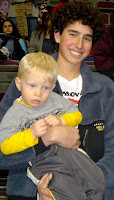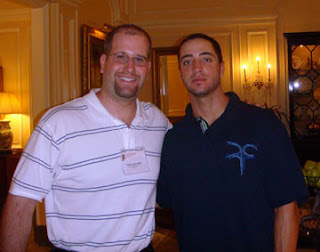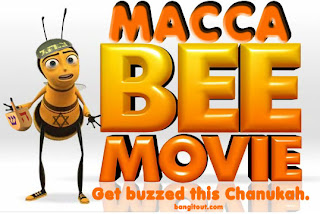There’s a great new animation from the Jewish Robot (AKA Ben Baruch; AKA William Levin) on the My Jewish Learning website to teach how to light the Hanukkah candles (see below). This is the first in a new series of viral marketing animations called “The Adventures of Todd and God.” It’s great that Levin’s using his creative talents to deliver Jewish learning through new media.
Category: Holidays
Rabbi David Ari Schuck, my friend and colleague, posted some really beautiful and inspiring thoughts about Hanukkah on his blog.
When we give something that we own to someone else, by definition, we lose the object. This means there is some type of loss involved in the giving. Often, the loss we experience is offset by the joy that we experience by seeing this object in the hands of its new owner.
Rabbi Schuck goes on to explain how the light of the candle enables us to give on a different level:
Light is different. When you light a candle, the light of the candle fills the room; it enables us to see things that would otherwise remain unseen in the dark. Despite the giving of the candle, the light is not diminished. It is one of the few exceptions to the rule of giving. A candle gives and gives, it illuminates everything in its vicinity, but loses nothing. We stand before the candles and we are bathed in their light. There is no shame in taking that light. The more of it we take, the more we will then emit. We will be moved, in a sense, to imitate the candles and learn how to give without feeling loss, without feeling that in some way we are diminished by the act of giving. This is very difficult, but it is a path on which those who work to refine their moral character must set out.
Read all of Rabbi Schuck’s “Hanukkah Thoughts for 5768” on his blog.
My family joins me in wishing everyone a Chag Urim Sameach – a very happy Hanukkah!
 I’m sure many people have long wondered where to get the best tasting soofganiyot (jelly donuts) in Jerusalem. Finally, one man has taken up this challenge. That man is Avery Robinson (pictured at left with my son at a Detroit Pistons game in 2005). Avery, a Detroit native and Frankel JAMD graduate, is in Israel for nine months as a participant on Young Judaea‘s Year Course. He has taste-tested the various offerings in Israel’s capital city and, through his blog, takes us on a virtual “journey through the various bakeries of Jerusalem.”
I’m sure many people have long wondered where to get the best tasting soofganiyot (jelly donuts) in Jerusalem. Finally, one man has taken up this challenge. That man is Avery Robinson (pictured at left with my son at a Detroit Pistons game in 2005). Avery, a Detroit native and Frankel JAMD graduate, is in Israel for nine months as a participant on Young Judaea‘s Year Course. He has taste-tested the various offerings in Israel’s capital city and, through his blog, takes us on a virtual “journey through the various bakeries of Jerusalem.”
 The Hebrew word sufganiyah derives from the Hebrew word for sponge (sfog) as its texture is similar to a sponge. In the month of Hanukkah (Kislev) Sufganiyot are sold all over Israel so Jews can observe the custom of eating fried foods in commemoration of the Hanukkah miracle of having enough Temple oil for eight nights.
The Hebrew word sufganiyah derives from the Hebrew word for sponge (sfog) as its texture is similar to a sponge. In the month of Hanukkah (Kislev) Sufganiyot are sold all over Israel so Jews can observe the custom of eating fried foods in commemoration of the Hanukkah miracle of having enough Temple oil for eight nights.
Potato Latkes are a delicious treat during Hanukkah, but having a religious/cultural excuse to consume jelly donuts cannot be beat (is there a blessing for cholesterol?). One of these years the Krispy Kreme franchise will wise up and become the world-wide corporate sponsor of Hanukkah.
Good luck to donut maven Avery and I look forward to hearing who’s selling the best hamantashen in Jerusalem this Purim!
Great movie parody poster at Bangitout.com
Yom Kippur was a Croc this Year
I definitely felt that my wife, kids, and I were the only ones not wearing Crocs this summer in Israel. Those weird-looking, plastic, comfy shoes have become the biggest foot fad since the Air Jordans. Ami Eden, in the JTA, reports that Crocs have taken over as the must-have shoes for Yom Kippur fashion… or at least a way to adhere to the “leather shoes are a no-no” rule. I’m going to stick with my black Chuck Taylor All-Stars for Yom Kippur. But maybe I’ll get a pair of Crocs for Tisha B’Av.
The Orthodox Union even ruled that Crocs are permissible on the Day of Atonement.
Eden writes in the JTA:
From secular beachgoers in Tel Aviv to right-wing Orthodox settlers in Hebron, Crocs — the bulbous-toed, open-back, rubber summer shoe — already were ubiquitous in Israel. Now, reports from several synagogues across America suggest, Crocs have surpassed Chuck Taylors, Keds, flip-flops and a host of other options to become the Yom Kippur shoe in the United States.
“It was so comfortable; I couldn’t believe how cushy it was,” said Steinerman, who opted for the subtle suit-matching black rather than one of the flashier Crocs colors. “Converse doesn’t have the right support. This was a big upgrade.”
From Facebook to My Space, Internet users have discussed the Crocs-on-Yom Kippur trend. And the reviews were not all positive. [more]
I go to the same temple as Kraft, so I’m pleased to report that he did an outstanding job chanting a lengthy haftorah portion (a selection from the prophets) before the congregation today, but things got a little bumpy at the end of the service when our rabbi rose to deliver the sermon.Her main trope was that people should act as as though God is always watching them. Not a bad lesson, except that in making her point she must have made an endless number of references to acting like you’re being videotaped. This was awkward.Somewhere in the middle of the sermon, she somehow managed to stumble onto a story about Cal Ripken, Jr. and what a positive role model he is (why she referenced Cal Ripken of all people, I have no idea–this sermon was all over the place). Her basic point was that Ripken always knew he was being recorded on the field, so he behaved accordingly. This was especially significant, she said, in this modern age where “sports scandal” is so prevalent.
Every year before Yom Kippur there has to be at least one article about whether a Jewish baseball player will play on the holiest day of the year. The Jewish community seems to get all excited about whether baseball players will suit up on Yom Kippur ever since 1934 when Detroit Tigers Hall of Famer Hank Greenberg chose to attend Yom Kippur prayer services at Congregation Shaarey Zedek in lieu of playing against the Boston Red Sox in a critical game in the middle of a pennant race.
 That year Greenberg played on Rosh Hashanah and hit two home runs that won the game, but didn’t play on Yom Kippur. Sandy Koufax made it a point to never play on Yom Kippur, even sitting out a World Series game in 1965 (although he did not go to synagogue). Some Jewish ballplayers like Shawn Green have been less consistent in taking off the Jewish holy day. In 2001, Green (then with the Dodgers) sat out an important pennant race game because of Yom Kippur. That same year Green appeared in more games than any other Dodger (161 of 162 games), and had the longest consecutive-game playing streak in the majors (408 games). That streak, however, came to an end when he didn’t play on Yom Kippur, a decision supported by the team. In more recent years, Shawn Green has opted to play in the night game on Erev Yom Kippur (Kol Nidrei) but not play on Yom Kippur day.
That year Greenberg played on Rosh Hashanah and hit two home runs that won the game, but didn’t play on Yom Kippur. Sandy Koufax made it a point to never play on Yom Kippur, even sitting out a World Series game in 1965 (although he did not go to synagogue). Some Jewish ballplayers like Shawn Green have been less consistent in taking off the Jewish holy day. In 2001, Green (then with the Dodgers) sat out an important pennant race game because of Yom Kippur. That same year Green appeared in more games than any other Dodger (161 of 162 games), and had the longest consecutive-game playing streak in the majors (408 games). That streak, however, came to an end when he didn’t play on Yom Kippur, a decision supported by the team. In more recent years, Shawn Green has opted to play in the night game on Erev Yom Kippur (Kol Nidrei) but not play on Yom Kippur day.“Though I didn’t grow up in a religious household, I was raised with a strong sense of identity. I was a huge baseball fan, just like lots of kids. At the time I was growing up, there really weren’t any well-known Jewish players (at least as far as I knew). I was, however, very aware of Greenberg and Koufax and the tremendous role models they were for Jewish people everywhere.
“As my baseball career progressed, I always remembered the decisions that the two greatest Jewish ballplayers made, and I told myself that if I was ever in their position to, in any way, fill that role, I would. Thus, I feel a strong responsibility to make the right choices when it comes to such topics as not playing on Yom Kippur. I’m not trying to be ‘the next Greenberg or Koufax,’ but I am trying to do my part as a Jewish ballplayer.”
 Well, this year there’s a new Jewish player making news in the big leagues. Ryan (“The Hebrew Hammer”) Braun (pictured at right) is on his way to becoming the first Jewish Rookie of the Year. I met Ryan Braun last month when he was staying with his team at the Ritz Carlton Hotel in Phoenix, Arizona during the Milwaukee Brewers’ series against the Arizona Diamondbacks. I found Ryan to be very friendly and I told him how great it is to have a Jewish athlete playing as well as he has been this year. In a very “small world” story, Ryan told me that he lived with his grandfather for a while in the same house that once belonged to Hank Greenberg.
Well, this year there’s a new Jewish player making news in the big leagues. Ryan (“The Hebrew Hammer”) Braun (pictured at right) is on his way to becoming the first Jewish Rookie of the Year. I met Ryan Braun last month when he was staying with his team at the Ritz Carlton Hotel in Phoenix, Arizona during the Milwaukee Brewers’ series against the Arizona Diamondbacks. I found Ryan to be very friendly and I told him how great it is to have a Jewish athlete playing as well as he has been this year. In a very “small world” story, Ryan told me that he lived with his grandfather for a while in the same house that once belonged to Hank Greenberg.LINDA MOREL
Jewish Telegraphic Agency
Did you know that Thanksgiving is really a Jewish holiday?
Although Thanksgiving is not on the Jewish calendar, historians believe Sukkot may have inspired America’s favorite farewell to fall, often nicknamed “Turkey Day.”
“The pilgrims based their customs on the Bible,” says Gloria Kaufer Greene, author of the “New Jewish Holiday Cookbook” (Times Books, $29.95 hardcover). “They knew that Sukkot was an autumn harvest festival, and there is evidence that they fashioned the first Thanksgiving after the Jewish custom of celebrating the success of the year’s crops.”
Linda Burghardt, author of “Jewish Holiday Traditions” (Citadel Press, $24.95 hardcover), says, “Sukkot is considered a model for Thanksgiving. Both holidays revolve around showing gratitude for a bountiful harvest.”
Today Thanksgiving is celebrated on the fourth Thursday of November, but President Franklin Roosevelt didn’t propose this timing until 1939.
It was Abraham Lincoln who made Thanksgiving a national holiday. Roosevelt actually changed Lincoln’s decree that Thanksgiving be observed on the last Thursday in November, which sometimes fell on the fifth Thursday of the month.
The pilgrims invited local Indians to the first Thanksgiving during the fall of 1621. Historians speculate that this celebration occurred somewhere between Sept. 21 and Nov. 9, but most likely in early October, around the time of Sukkot.
“Originally, Sukkot entailed a pilgrimage to Jerusalem,” says Greene, who believes the two holidays share much in common. […more…]
